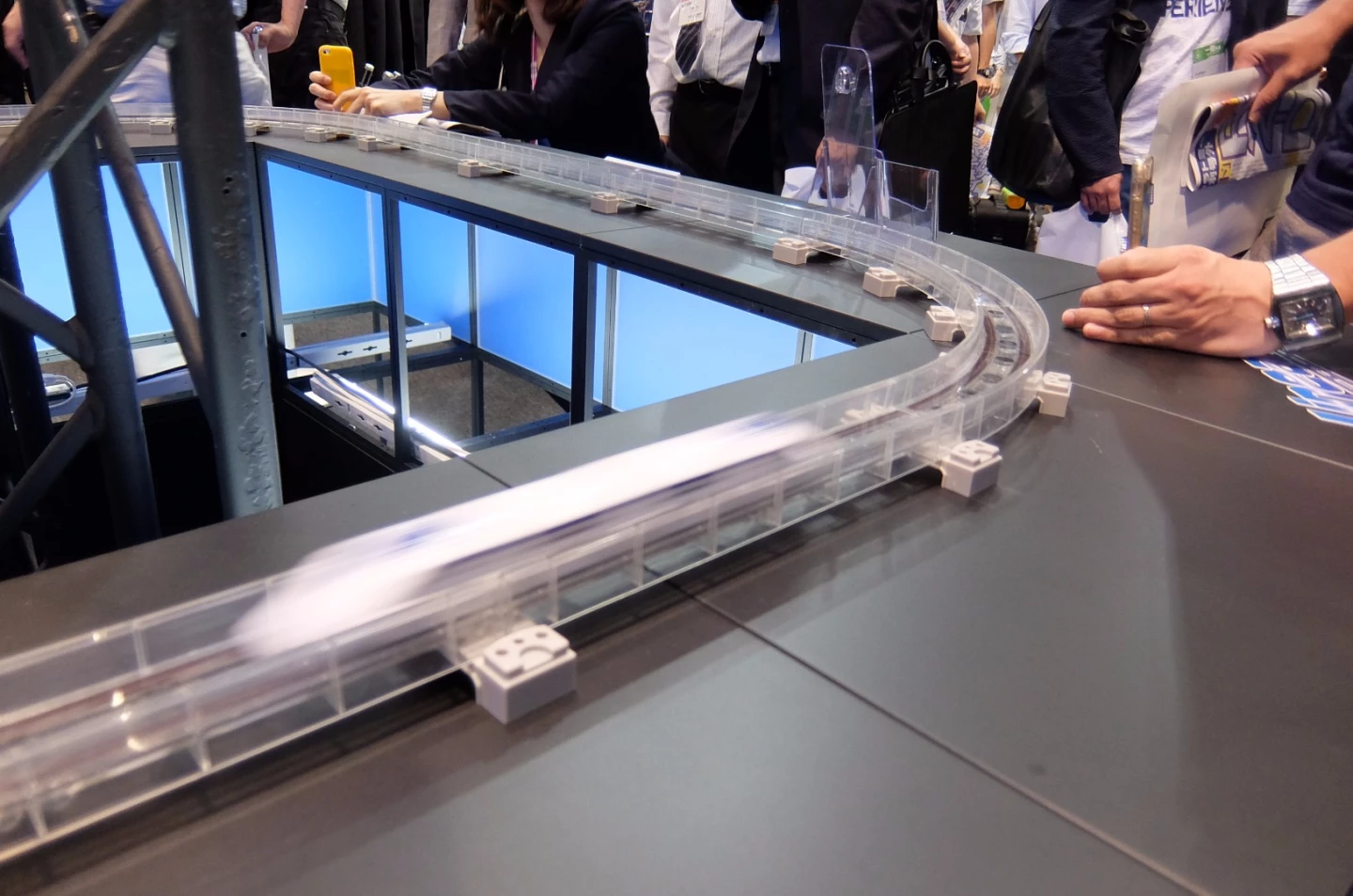Japanese toy company Takara Tomy is offering a working scale replica of the record-breaking 603 km/h (375 mph) SC Maglev (Superconducting Magnetic levitation) Train. However, all is not what it seems, as it is more than just a 1/90th scale facsimile of the real thing. The Linear Liner uses an original magnetic propulsion system, and has an intriguing creation story behind it.
The initial driving force behind the Linear Liner, and any magnetic levitation type of transportation, is the dream of eliminating most or all of the drive friction required for moving. This is achieved by floating, through the repulsion forces between two polar identical magnets. Takara Tomy's initial research in the spring of 2013 showed that replicating an electrified track (known as a smart track) for a miniature SC Maglev would result in a toy well beyond the price range of most customers. So the company opted for a cheaper and simpler non-electrified track (a dumb track), which meant the train became the complex unit.
Floating solution

The solution to making a simpler non-electrified track literally came from the magnetic whiteboard the engineers were using to explain their ideas. They realized and physically proved that a long magnetic strip still retains its north/south polarity on opposite sides along its entire length, even at a thickness of around a millimeter. And at these thicknesses, it was possible to bend the magnet into a curve, if clad in rubber.
To levitate the train, a duplicate of the same arrangement of magnets was made along the length of the underside of each of the cars to achieve the required repulsion force. It was decided to make one concession to wheels for increased lateral stability, by adding small guide rollers mounted horizontally on each side of each car. These guide rollers center the Linear Liner and maintain the magnetic levitation height of 2 mm. To keep the illusion and dream of pure magnetic transportation, these rollers run along a transparent sidewall that literally keeps the train on track.
Punting along

By the end of 2013, almost a year into the project, the toy designers at Takara Tomy had something that levitated but did not move, unless it was pushed. But they were determined that this pushing force would not come from air and especially not from powered wheels.
Enlightenment arrived in the bath, when one of the engineers realized that by pushing occasionally with his hands on the bottom of the bathtub, he moved backwards and forwards in the bath when floating. As momentum was kept, due to the low friction of floating, he only needed to apply a force occasionally to move – a technique similar to the river art of punting. What was needed was a switchable high-speed electromagnet that occasionally applied repulsion (pushing force) to the train, but only from the rear backwards. To time this on/off repulsion force correctly to the regular embedded magnets in the middle of the train tracks, they needed a sensor.
Initially, at the beginning of 2014, the timing was not correctly matched, and the Linear Liner was painfully slow. Trial and error gradually improved the performance, and it was found the angle of the magnetic sensor, the length of the wire and the spacing of the magnets at 4 cm (1.6 in) apart, were critical factors.
The prototype debuts

The improved prototype made its debut at the Tokyo Toy Show in June 2014, and Gizmag was granted permission to photograph it. We were even lucky enough to do a short interview with the chief designer, where we got a brief insight of the Linear Liner's history and production plans.
One interesting point was that the Takara Tomy Linear Liner reached a scale speed of 600 km/h (373 mph) in June 2014, a good six months before the real SC Maglev achieved the feat in February 2015.
Final working form

One year later, in June of this year at the 2015 Tokyo Toy Show, the pre-production model was launched to the press and public alike. Such was its speed that it proved quite difficult to photograph, and many a photographer had to resort to the old art of panning to get a shot.
So how does it work?

1) At the front of the train the on-board magnet sensor senses an incoming rail magnet (B) and tells the on-board electromagnet to switch itself on.

2) This timing correctly matches the extact position for the on-board electromagnet to exert a (north) repulsion force from the rear on the previous outgoing track magnet (C), pushing the train forward.

3) The on-board sensor then detects that it has reached the incoming track magnet (B) and so switches off the on-board electromagnet.

4) This allows the train to glide over this incoming track magnet (B), thus not getting a repulsion force (stopping force) from it.

5) The sensor then picks up another incoming track magnet (A) and so switches the on-board electromagnet on, getting a repulsion force from the recent (glided over) track magnet (B).

6) The on-board sensor now tells the on-board magnet to switch itself off, before it gets a repulsion force from this incoming magnet (A).
To move faster, a signal is sent to the train to increase the power of the "push" and speed up the process of switching on and pushing, and switching off and then gliding.

What price for all this technology? The answer is around ¥38,000 (US$316). This may seem a little expensive for just one train measuring 251 mm (9.9 in) in length and a small oval track. However, what you are getting is not only a novel kind of magnetic propulsion system, but also the fastest toy train in the East and perhaps the West as well.
Take a look at the video below, to see just how fast the Linear Liner moves at full speed.
Source: Takara Tomy



















